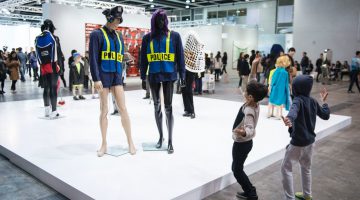Jeremy Shaw
“Trancendental Capacity ”
Macaulay & Co. Fine Art, Vancouver
January 17 – February 28, 2013
Last year, during Art Basel 43 in Switzerland, Absolut Art Bureau commissioned the Canadian artist Jeremy Shaw to design a bar in the upstairs gallery of the Volkshaus, an old mansion within walking distance of the fair. Shaw transformed the room, which was originally used as a library but repurposed after the building’s renovation by Swiss architects Herzog & de Meuron, into an immersive installation. Large bushes made of banana leaves, palm fronds and ferns were potted together around the room, and performers were invited by the artist to play music from the balcony that encircled the wood-paneled space. Each night the room was illuminated by black-light bulbs and green lasers, and the custom-made glow-in-the-dark invitations shone every time a handbag was opened. A functioning arcade terminal for the Atari game Tempest, where the user navigates a laser-like grid, was positioned in the corner. The artist even created a drink available on the menu designed to have an aftertaste. “Anything is better,” said Shaw, “if it provides a lingering memory.”
The bar was named The Kirlian, in honor of a historical photographic technique that Shaw used to make new artworks currently on show at Macaulay & Co. Fine Art in Vancouver, B.C., his native city (he has since become a naturalized Berliner after living in Germany for the last ten years). In fact, all of the elements in the bar’s design reflect the enduring interests and themes of Shaw’s practice: kirlian photography, black-light prints, appropriated commercial animations, music, nightclub and drug culture. The kirlian prints were made by pressing his index finger onto a piece of Polaroid film laid on a copper plate surface through which an electrical current was passed. Listening to classic pop songs that were thought to have ‘transcendent’ qualities as he did this, the resulting image of a Technicolor fingerprint captured the artist’s magnetic field, in theory visually depicting his aura as he listened to a song. The stronger the intensity of color and shape in the image, the more the artist was affected by the words and music.
Art Salon | Lecture Performance | ‘I Am a Laser/Scream Like a Baby,’ in correlation with the ‘based in Berlin’ exhibition from Art Basel on Vimeo.
A year earlier, Shaw was invited by Art Basel 42 to give an artist talk as part of their Salon series. The resulting work, I Am A Laser/Scream Like A Baby, was a twenty-three minute performance that deconstructed the classic delivery of a scientific paper at a trade conference. Written as if for an academic audience of scientists, Shaw recounted in chronological order the history of the development of the free-electron laser and its evolution into photoacoustic spectroscopy, or the study of the interaction between radiated energy and matter. But halfway through his presentation the dry, specialized language of the profession was interrupted: the lights dimmed, the plotted line-graphs of the PointPoint presentation morphed into a green laser slideshow and Shaw’s microphone audio was distorted by a vocoder, transforming his speech into a robotic voice. Accompanied by recorded music he sang a four-minute song before the lights come back up, the scientific graphs re-appeared and he resumed his lecture as if nothing had happened. The performance demonstrated what it was physically like to pass from one consciousness to another.
The idea of what the artist termed an ‘archaic-future,’ or what it felt like to not be in the present, was a concept that influenced him to re-visit the genre of time-travel. The second series currently on display at Macaulay & Co. in Vancouver investigates the concept of history and chronology through the visual depiction of time-travel. Since 2008 Shaw has been making This Transition Will Never End, a silent video montage of appropriated imagery from Hollywood movies depicting scenes that represent the slippage of time, or a transition from one reality to another. The piece is “a history of the special effects techniques used to create the swirling, vortex-like portal representations throughout cinema over the past sixty years thus far, albeit not in chronological order.” By watching the intercutting of various mechanical production techniques like filming through coloured glass, or split-scan animations, or advanced computer graphics, the viewer experiences different realities at once. Being mesmerized one minute by a confounding moving image and then falling backward into memory when a familiar clip is recognized causes the audience to move back and forth in time, challenging their perception of space and location. Jeremy Shaw’s practice exercises these shifting moments between memories and their material realization, and admits that their historical explanation can only be achieved when the truth is left up to the imagination.
– Lucas Soi
Roux, Caroline. “Kirlian Bar by Jeremy Shaw at Art Basel.” Wallpaper. Web. 25 June 2012 <http://www.wallpaper.com/architecture/kirlia-n-bar-by–jeremy-shaw-at-art-basel/5899#65498DD>
Macaulay & Co. Fine Art – Press Release
Bang Larsen, Lars. “PCP: Pop/Conceptual/Psychedelic.” C Magazine Spring 2009: 16 – 21. Print
Ibid 20.





